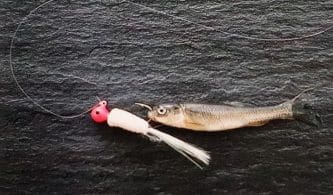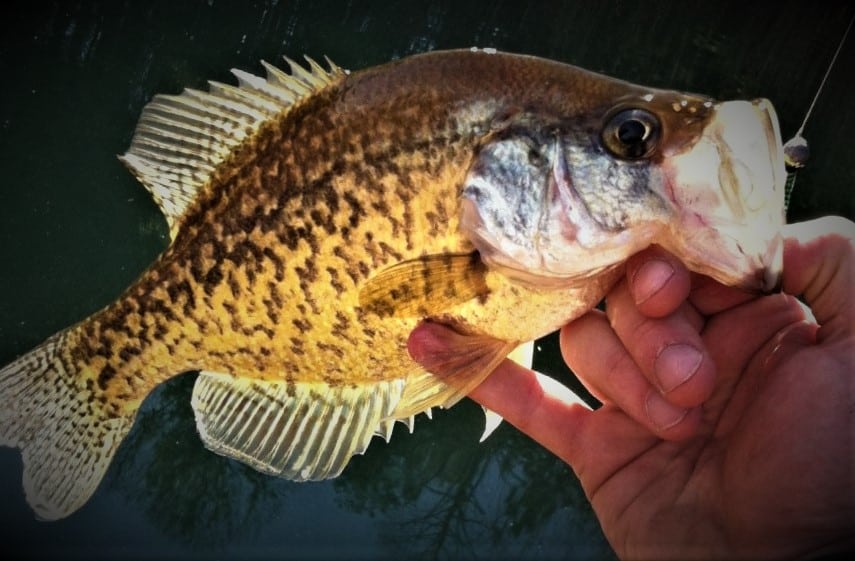More crappies are caught on small baitfish than on all other baits and lures combined. All serious crappie fisherman need to learn how to properly fish minnows. Most adult crappie eat a diet mainly consisting of small fish, so it’s only natural for them to be attracted to minnows. When your usual jig isn’t working minnows are the perfect alternative.
Crappie Fishing With Minnows
I’ve already taught you how to catch and keep baitfish alive, but how do you actually fish them? Luckily it’s extremely easy to fish for crappie using minnows. There’s a wide variety of small baitfish marketed towards crappie fisherman. Most fisherman prefer Fatheads and Shiners, but small Chubs and Dace work as well. Large Crappie, yellow perch and white bass will all take a minnow. Your average minnow should range from 1.5-2 inches long with a max length of 3 inches. Use larger minnows if you’re trying to avoid smaller sunfish like Bluegill. Most sunfish ignore minnows longer than 1 inch.
Spring Fishing
When the shallows start to warm up in spring minnows start to move out. They tend to travel into quiet bays and sunny shorelines. Since minnows are their primary food source, the crappies are not far behind. To be successful in the spring you’ll need to go where the fish are. Look for schooling minnows and other small baitfish. Most shore fisherman will use a bobber and minnows or jig-minnow combo.
Summer Fishing
Later in the summer large crappie try and avoid the warmer water. They move out to deeper cover looking for cooler temperatures. They frequently hang around large rocks in the middle of the lake and other submerged brush. Use your fish finder to look for sunken objects and large pieces of wood. During the day they may suspend in deep water away from cover. Your best bet is to use either a slip bobber or tandem hook rig fished vertically.
Hooking Minnows
Hooking minnows is an important skill for any fisherman. It will mean the difference between a lively minnow or dead worthless bait. When done properly you’ll be sure to catch a ton of crappie. To avoid killing your fish you’ll need a thin hook or jig. Minnows are very fragile fish so you’ll need to handle them with care. Not only will thin hooks be less likely to kill minnows, they’re also harder for fish to see.
Choosing The Right Hook
Choosing the right hook will depend entirely on the size minnow you use.
- 1-1.5 in Minnows:
- 1.5-2 in Minnows:
- 2+ in Minnows:
How to Hook a Minnow
- Hook a minnow through its lips when trolling or repeatedly casting. If you expect a lot of movement you’re better off hooking through the lips. When hooking a minnow through its lips first start with the lower lip and then thread it through the top. Make sure the hook is pointing upwards so the minnow swims upright. Hooking a minnow through its lips will eventually die so make sure you check it frequently
- You can also hook a minnow through its back when still fishing. This is the perfect method when using a slip-bobber or other still setup. Hook a minnow through its back by inserting the hook behind its rear dorsal fin. This type of setup will allow the fish to swim more naturally and last a while before death. Just try not to hook the moon through the spine, because it will quickly paralyze it.
How to Fish a Jig and Minnow
Hooking Your Minnow
One of the easiest ways to catch crappie is to fish a jig and minnow. To fish a jig/minnow hook your 1.5 in minnow through the lips on a 1/16-1/8 ounce jig. I like to pair the Strike King Mr. Crappie Jig Head with a small soft plastic grub. Tie your jig directly to a 4 to 6 pound mono filament line. In heavy brush use a bobber to suspend your rig just above the cover.
Casting The Jig
Cast the jig and minnow letting it sink until it hits the bottom. Retrieve slowly trying to hop the jig along the bottom. Most of the time fish will grab the jig as it drops. Make sure you keep a tight line so that you’ll be able to detect a strike.
Bobber and Float Rigs
Bobber fishing is easily the most common technique when fishing minnows. Bobbers allow you to completely control the depth easily catching suspended fish. You can’t forget about the added benefit of seeing your bites. I like to use a split-shot bobber about 1-2 feet above my hook. I like to adjust my sinker slowly changing my depth as the day goes along. Start off fishing the surface and slowly work your way down.
In most situations you’re going to want to use a slip bobber, but fixed bobbers can work as well. The only time I’d use a fixed bobber is if I’m fishing during the spawn. Fishing shallow waters doesn’t require as much experimenting to get the job done. Everybody’s fished using a bobber, so there’s not much that needs to go into it. Try keeping your bobber in one place first and throw in a slow retrieve to change things up.
Rigging a Slip Bobber
Many fisherman love crappie fishing but don’t really understand what a slip bobber is, or how to rig them. The slip bobber is made out of a straw like tube surrounded by a float. The line is inserted through the tube allowing it to slide freely on your line. It’s the perfect setup when used in conjunction with a fish finder. You’ll be able to dial in the perfect drop for effective fishing.
How to Setup a Slip Bobber
- Thread a commercial slip-knot a bead and a slip-bobber onto your line.
- Add a split shot and insert a #4 or #6 hook just below your minnows dorsal fin.
- Watch your fish finder to determine the exact depth needed for fishing. If you’re not using a fish finder try to determine the depth of any substructure below.
- Set the slip-knot to the correct depth by measuring the line between your arms. The length between your full arm length as close to equal your height. You don’t need to get the perfect length as long as you don’t snag on bottom growth.
Tie a Tandem Hook Rig
- Tie two dropper lines with a stiff 20 pound mono and #4 Hooks

- With a 12 pound mono tie off your first hook. Form a double strand 15 inches from the end and pass it through the dropper loop. Tie an overhand knot then pass the hook through the doubled line and snug up the knot.
- Tie on another dropper 15 inches above the first one.
- Add a bell sinker to the bottom of the 12 pound mono
Still Fishing
Still-fish a tandem hook rig around underwater cover. Look for underwater weeds, brush, stumps and other cover. To find large crappies suspended in open water troll slowly or drift while varying the depth.

